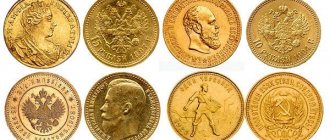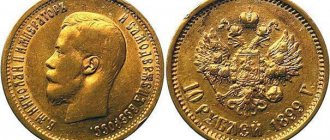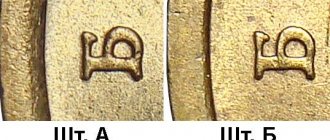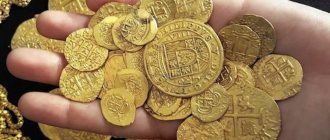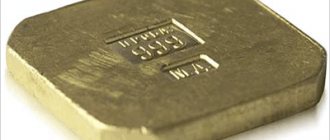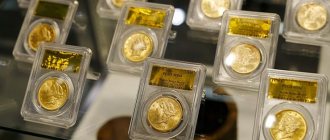History of Spanish coins
The history of coinage in Spain goes back 2,400 years. These coins circulated throughout most of the Iberian Peninsula during the reigns of the Greeks, Phoenicians, Iberians, Carthaginians, Muslims, feudal lords, kings, republicans and dictators.
The oldest coins minted on the Iberian Peninsula date back to around 400 BC. e. We are talking about silver obols issued by Emporion, the first ancient Greek colony on the east coast of the peninsula. This is not surprising, because it was thanks to the Greeks that throughout the Mediterranean they began to use money as a means of payment when concluding trade transactions. The Spaniards made their first coins on the model of silver drachmas, which Greek settlers used to pay for goods. In the city of Rhodes (near Emporion), coins began to be minted in the 4th century BC. e. At the beginning of the 3rd century BC. e. coins began to be issued in another part of the peninsula - in Cadiz. However, these coins were made of bronze and, moreover, on the model of Phoenician metal money.
In 1868, the peseta came into circulation, forever replacing the reales, escudos and maravedis issued by the Castilian crown for many centuries.
Later, with the growing trade expansion of the Carthaginians, their coins found their way to cities on the Mediterranean coast.
Around 220 BC e. Cartagena, Castulo and Sagunto, which maintained close ties with Carthage, opened their own mints and began minting coins, the design of which, of course, was influenced by the metropolis.
But the heyday of coinage came on the peninsula during the period of Roman colonization, which began at the end of the 3rd century BC. e. Most of the coins issued at that time were directly related to the Roman conquests. Thus, many of them went to pay the salaries of the military in the border areas. The Iberians issued coins mainly for trade with the colonialists. The gradual Romanization of Spain led to the fact that the peoples living on the peninsula were forced to accept the unified monetary system of Rome, and therefore, only one mint, authorized by the authorities of the republic or empire (depending on the era), could mint coins.
Escudo and escudillo
Spain quickly recovered from Arab rule and, already at the end of the 16th century, positioned itself as a prominent global player. In 1535, a 917 gold escudo was minted in Barcelona. This Spanish gold coin weighed four grams and contained at least three grams of pure gold. The escudo soon became the country's national coin. They were minted by the Madrid mint, but there were individual copies minted in the colonies.
Escudos were minted until 1868. The exchange rate depended on the political situation and the price of gold. In 1566, one escudo was offered at 400 maravedis, but a century later it was already worth 16 reals.
The escudillo was used as a small change. The net weight of gold in it was 1.5 grams. It is known to contemporaries and numismatists as the golden piastre.
The era of Visigoth and Muslim rule
In 409 AD BC, when the Roman Empire began to decline, Emperor Constantius entered into an agreement with the Visigoths, transferring to them the Iberian Peninsula. This Germanic people had their own currency. However, the impeccable condition of the gold coins minted by the Visigothic kingdom in the 6th-7th centuries suggests that the money was not used in trade or economics, but rather served as a means of propaganda or confirmation of the legitimacy of power. Consequently, in that era, the inhabitants of the peninsula used coins issued by the Roman Empire.
The situation was completely different during the period of Muslim rule. The Arab conquest of the peninsula began in 711. Just five years later, the Muslims established control over most of Spain, which became known as Al-Andalus. In addition to dramatic political changes, the inhabitants of the peninsula also had to get used to a new monetary system, since the Arabs approved the monetary system of the Umayyad Caliphate.
The first coins were minted in the ancient Greek colony of Emporion around 400 BC. e.
The history of coins from the Al-Andalus era goes back seven centuries. During this period, they underwent several significant changes, which are explained by historical vicissitudes and changes in rulers in the region. The first coins were minted in the mid-7th century after independence from the central government of Baghdad. These were mainly silver dirhams and fels, which are today known as emirate coins. Later, when the caliphate was formed on Spanish lands, gold dinars also appeared in circulation. But the most important changes occurred in the 11th century, when the caliphate broke up into many independent emirates, or taifas, many of which began minting their own money.
The reunification of territories under the rule of the Almoravids (between the 11th and 12th centuries) and the Al-Mohads (at the end of the 12th century) returned a unified monetary system. But the days of dirhams, dob-lovs, dinars and other coins of Al-Andalus were numbered, as the troops of Christian rulers, advancing from the north, gradually reclaimed the lands from the Arabs. In 1492, Muslims were expelled from their last enclave on the peninsula, Granada.
Golden age
Despite the name, silver banknotes were widely used during this period. The first ancient Spanish silver coin of the era was the real. It was first released during the reign of Pedro I after the complete expulsion of the Arabs from the country. The weight of the product was 25 g. Externally, the sign was not elegant. On the obverse was the coat of arms of Castile, on the reverse - Fr. Changes occurred at the beginning of the 16th century - the face of the current monarch appeared on the disk. Over time, the value of the real declined as currency reform replaced silver with copper.
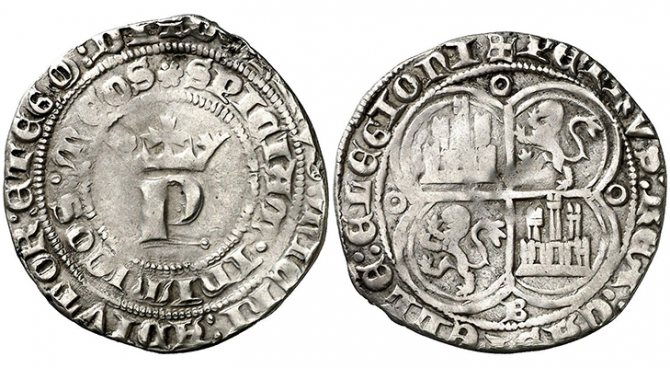
In 1497, the silver peso was issued for the first time. At this time, Spain began to actively develop the lands of Central America (the modern territories of Mexico, Peru, Bolivia), which led to the appearance of a large amount of precious metals in the country, so the minting of a new currency was large-scale. Production was carried out at 11 enterprises. The appearance of the product was also quite modest. The coat of arms and the number VIII were applied to the disc. From the 2nd half of the 18th century, an image of the monarch appeared.
The peso had several names:
- duro – equal to 20 reais;
- ship's peso - blanks for issuing duro;
- piastres.
Money spread throughout the colonies, where it was used until the beginning of the 20th century. In Spain itself, instead of the heavy peso, the peseta (“small peso”) appeared.
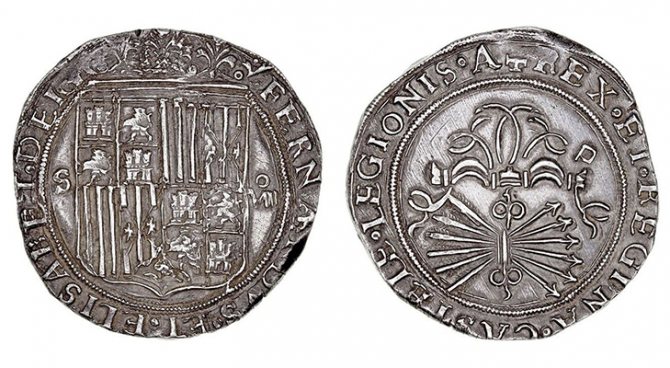
Another old small Spanish coin is the silver escudo, which appeared in 1864. The sign was equal to 10 counting reals or 100 escudo centimos. The products remained in use for only 5 years until the next monetary reform in 1868 and Spain’s accession to the Latin Monetary Union. The face of Isabella II was printed on the obverse, and the coat of arms was printed on the reverse.
Christian coins of the Middle Ages. Unification of the monetary system
The territories in the north of the peninsula, conquered by Christian troops, were characterized by a complex government structure. At the same time, the rulers of different states minted their own coins. As a result of the gradual unification of territories and the subsequent unification of the monetary system, by the 11th century, three large kingdoms were formed that issued money: Aragon and Catalonia, Castile-Leon and Navarre.
At the end of the 15th century, the so-called Catholic kings came to power and took the first important steps towards creating a unified monetary system in the territory of the two kingdoms they ruled: Castile-Leon and Aragon. Spain of that period became famous for its expansionist policies. For example, in 1492, having finally expelled the Arabs from the peninsula, Spain sent Christopher Columbus on an expedition, beginning the exploration of America.
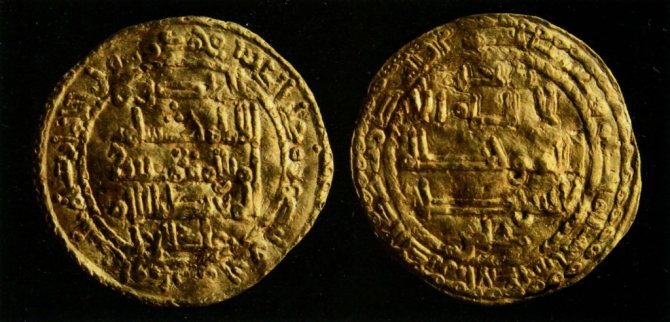
The emirate and the caliphate approved a single monetary system for all of Al-Andalus. However, in the 11th century, as a result of the collapse of the caliphate, separate taifas were formed, many of which began to issue their own coins.
In order to centralize the monetary systems used in their domains, the Catholic kings unified the value of coins in circulation and developed uniform coinage standards. At that time, the most valuable coin was the real, on one side of which a coat of arms was invariably minted, symbolizing the union of the two kingdoms. The real remained in circulation until the 18th century. In addition to the real, the monetary system also included other coins, such as the quarto, escudo, and maravedi.
When Charles II died in 1700, the reign of the Habsburg dynasty ended.
DID YOU KNOW THAT... Some kings of Castile issued coins that had no numismatic value and were minted for propaganda purposes, such as the cinquantin issued in the 17th century by Philip III.
After a somewhat protracted war for the throne, the Bourbon dynasty came to power, which rules to this day. King Philip V of Bourbon established a new monetary system that was stable and included copper maravedis, silver reals and gold escudos.
Priceless cultural monuments
Metal money has always been of interest. Of particular value are gold coins that are able to maintain their appearance even in the most unfavorable environment. An ancient treasure recovered from the ocean floor off the coast of Florida is striking in the degree of preservation of the finds. These treasures, valued at almost $5 million, are ready to go straight from the seabed to any prestigious antique auction, even without prior preparation. It is difficult to imagine how much useful information specialists, numismatists, collectors, and historians can obtain by unraveling the secrets of silent witnesses. Spanish gold has gone along with brave sailors and adventurers through difficult milestones of human history and is ready to tell the world its secrets.
Peseta
The Spanish monetary system underwent dramatic changes in 1868, when the Minister of Economy announced the transition to a decimal system. The peseta was adopted as the new monetary unit, which in turn was divided into 100 centimos. From then until the abolition of the currency in 2002, all coins were minted according to the same pattern: the national coat of arms of Spain was minted on one side, and the portrait of the head of state on the other.
During the existence of the Second Spanish Republic, instead of a portrait of the monarch, allegorical motifs appeared on coins, reflecting the principles of the republican system. When civil war broke out in the country in 1936, each side in the conflict began to issue its own currency. Republicans soon faced a metal shortage problem. In this regard, many municipalities began to issue paper banknotes that were recognized only in their area. The unity of the monetary system was restored in 1939 after the victory of the Republicans and the establishment of the regime of Francisco Franco. By order of the dictator, his portrait appeared on almost all coins. The dictatorship lasted until the mid-1970s, and the end of this stage was reflected in the coins, although the design changes were insignificant: the coat of arms of Francoist Spain was replaced by the coat of arms of the constitutional monarchy, and the portrait of Franco was replaced by a portrait of King Juan Carlos I. Also in those years, fractional centimos disappeared, and 1 peseta became the smallest coin in the monetary system. Subsequently, sports themes, cultural and architectural elements appeared in the design of coins. Finally, on January 1, 2002, the euro was introduced in Spain. The national monetary system ceased to exist.
